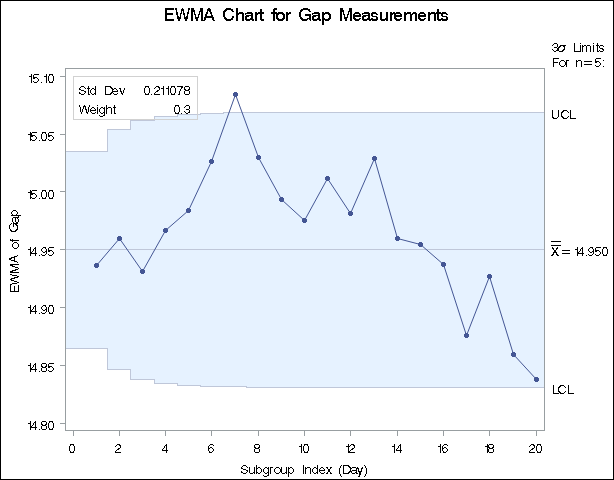INSET Statement: MACONTROL Procedure
| Getting Started: INSET Statement |
This section introduces the INSET statement with a basic example showing how it is used. See INSET and INSET2 Statements: SHEWHART Procedure for a complete description of the INSET statement.
This example is based on the same scenario as the first example in the "Getting Started" section of EWMACHART Statement: MACONTROL Procedure. An EWMA chart is used to analyze data from the manufacture of metal clips. The following statements create a data set containing measurements to be analyzed and the EWMA chart shown in Figure 9.18.
data Clips1;
input Day @ ;
do i=1 to 5;
input Gap @ ;
output;
end;
drop i;
datalines;
1 14.76 14.82 14.88 14.83 15.23
2 14.95 14.91 15.09 14.99 15.13
3 14.50 15.05 15.09 14.72 14.97
4 14.91 14.87 15.46 15.01 14.99
5 14.73 15.36 14.87 14.91 15.25
6 15.09 15.19 15.07 15.30 14.98
7 15.34 15.39 14.82 15.32 15.23
8 14.80 14.94 15.15 14.69 14.93
9 14.67 15.08 14.88 15.14 14.78
10 15.27 14.61 15.00 14.84 14.94
11 15.34 14.84 15.32 14.81 15.17
12 14.84 15.00 15.13 14.68 14.91
13 15.40 15.03 15.05 15.03 15.18
14 14.50 14.77 15.22 14.70 14.80
15 14.81 15.01 14.65 15.13 15.12
16 14.82 15.01 14.82 14.83 15.00
17 14.89 14.90 14.60 14.40 14.88
18 14.90 15.29 15.14 15.20 14.70
19 14.77 14.60 14.45 14.78 14.91
20 14.80 14.58 14.69 15.02 14.85
;
title 'EWMA Chart for Gap Measurements';
symbol v=dot;
proc macontrol data=Clips1;
ewmachart Gap*Day / weight = 0.3
nolegend;
inset stddev weight;
run;
Figure 9.18
Exponentially Weighted Moving Average Chart with an Inset
